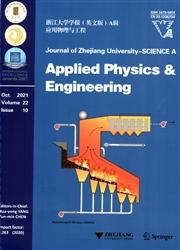Two-stage identification of interlayer contact loss for CRTS III prefabricated slab track based on multi-index fusion
IF 3.9
3区 工程技术
Q1 ENGINEERING, MULTIDISCIPLINARY
引用次数: 2
Abstract
To accurately identify the potential contact loss of the China railway track system (CRTS) III prefabricated slab track, a finite element model with contact loss of self-compacting concrete (SCC) under transient impact was established. Then the vertical accelerations near impact points on the track slab surface were extracted to obtain damage-sensitive indices in the time and frequency domains. The indices were initially normalized to obtain independent items of evidence before the Dempster-Shafer (D-S) evidence theory was used to fuse these into one. Finally, a two-stage identification was performed to identify the damaged SCC area, comprising a rough identification (Stage I) and a precise identification (Stage II). The research results show that the damage indices extracted based on the transient impact response change abruptly at the damage location, and that can be used for damage identification. However, the use of a single index to determine the damage of the impact point may be misjudged. In Stage I, five damage indices of acceleration were fused to magnify the difference between the damaged point and undamaged point, thereby improving the accuracy of finding damage. In Stage II, in the area where more impact points were added, a fusion of three indices of acceleration response, that is, the absolute mean of the time domain, the maximum amplitude of the frequency domain, and the power density ratio, further narrowed down the area where damage exists. As a result, when the contact loss of SCC is greater than 50% along the thickness direction, the identification accuracy can be as high as 70% to 80%. The two-stage identification method proposed in this study can greatly improve the efficiency of interlayer damage detection of slab tracks and is expected to provide effective technical support for damage identification of track structures in the future.基于多指标融合的CRTS III预制板轨道层间接触损失两阶段识别
为了准确识别中国铁路轨道系统(CRTS) III预制板轨道的潜在接触损失,建立了考虑瞬态冲击下自密实混凝土(SCC)接触损失的有限元模型。然后,提取轨道板表面撞击点附近的垂直加速度,在时域和频域上获得损伤敏感指标;在使用Dempster-Shafer (D-S)证据理论将这些指标融合成一个证据之前,这些指标最初被归一化以获得独立的证据项。最后,采用粗糙识别(阶段1)和精确识别(阶段2)两阶段的方法对SCC损伤区域进行识别。研究结果表明,基于瞬态冲击响应提取的损伤指标在损伤位置发生突变,可用于损伤识别。然而,使用单一指标来确定冲击点的损伤可能会被误判。在第一阶段,将5个加速度损伤指标进行融合,放大损伤点与未损伤点的差异,从而提高损伤发现的准确性。在第二阶段,在增加更多撞击点的区域,将时域的绝对平均值、频域的最大幅值和功率密度比这三个加速度响应指标进行融合,进一步缩小了存在损伤的区域。因此,当SCC沿厚度方向的接触损失大于50%时,识别精度可高达70% ~ 80%。本研究提出的两阶段识别方法可大大提高板式轨道层间损伤检测的效率,有望为未来轨道结构损伤识别提供有效的技术支持。
本文章由计算机程序翻译,如有差异,请以英文原文为准。
求助全文
约1分钟内获得全文
求助全文
来源期刊

Journal of Zhejiang University-SCIENCE A
工程技术-工程:综合
CiteScore
5.60
自引率
12.50%
发文量
2964
审稿时长
2.9 months
期刊介绍:
Journal of Zhejiang University SCIENCE A covers research in Applied Physics, Mechanical and Civil Engineering, Environmental Science and Energy, Materials Science and Chemical Engineering, etc.
 求助内容:
求助内容: 应助结果提醒方式:
应助结果提醒方式:


